Handheld Classics Today and Tomorrow
The first smartphone from the company Palm has finally entered the fair free market, without reference to the operator. Released last fall, the operator Vodafone, Treo 500 was the first palm on Palm based on the Windows Mobile platform for smartphones, that is, without a touch screen. Until the end of 2007 the operator had the exclusive right to sell the smartphone, and now the European division of Palm released officially "unlocked" version. In most European countries, Palm Treo 500 will cost about 399 euros, while in the UK - 269 pounds, that is about $ 530. According to a not too merciful price smartphone, Palm will have to face many competitors, ranging from the Samsung Ultra Messaging i600 and ending HTC S620 (Excalibur) with MOTO Q q9.
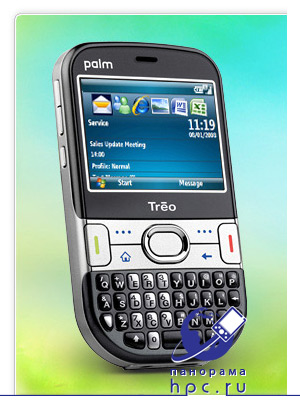 |
Recall that the Treo 500 is classic for Palm candybar with QWERTY-keyboard. According to their tactical and technical parameters it does not have any appreciable advantage over competing devices. Despite positioning as a compact model, Smartphone Palm rests on the same level as competitors. Moreover, eye-catching such serious shortcomings as lack of support for wireless networking Wi-Fi and high-speed mobile standard HSDPA. Summarizing it may be noted that Palm is too late with the release of such a device at this price. The network has information about a pair of Palm PDA with an eye to the future. First, it became known details about the new device based on Windows Mobile codenamed Treo 800w. WMExperts has appeared on the resource description models for networks with support for CDMA2000 EV-DO Rev. A, but all indications are that similar features will have and GSM / HSDPA version of the future new products, code-named Drucker. The very long-awaited smartphone Palm, finally received the support of an integrated GPS and Wi-Fi (802.11 b / g), will be on sale in April. He will come with a Windows Mobile 6, but will be compatible with Windows Mobile 6.1 and Service Microsoft System Center Mobile Device Manager 2008, when there will be an update. The device differs subtlety, with a thickness of about Palm Centro. At the bottom there is a connector mini-USB, especially the source of the lack of 3.5-mm headphone jack, that is to connect will have to either use an adapter mini-USB, or use wireless headphones via Bluetooth 2.0 + EDR. In addition to the classic button to activate / deactivate the call will be the appropriate hardware key to enable / disable the module Wi-Fi.
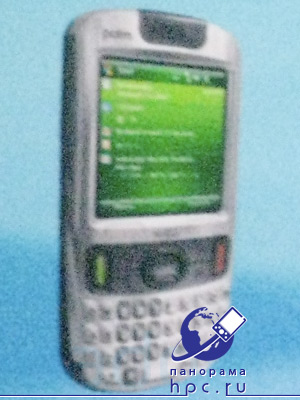 |
Besides the fact that this is the first Treo smartphone with GPS and Wi-Fi, the device will be the first Treo based on Windows Mobile touch screen resolution of 320x320 pixels. Earlier Treo based on Windows Mobile models lost on Palm OS in terms of display resolution. Built-in memory also promises to be improved. The description specifies 256 MB of internal memory, apparently, is meant only ROM-memory. The rest of the communicator is unlikely to stand out from the crowd, referred to a 2-megapixel camera, slot for memory cards microSD. Thus remain unknown to the nuances of such as CPU and screen diagonal. Perhaps at the upcoming February exhibition will be announced official details. Secondly, in a European online stores appeared a separate page for the GSM-version of Communicator Palm Centro. Special marks reports that the model will soon be on sale. At the moment, Palm Centro just released in a version for the CDMA network and is sold in the U.S. operator Sprint. Fans of the classic Palm PDA is definitely please the news about the imminent release of a model that is applicable in our GSM-networks.Palm Centro is represented as the smallest of all smartphones Palm. He is running the operating system Palm OS 5.4, equipped with a 1.3-megapixel camera, 64 MB of internal RAM-memory card slot format microSD, supports GSM networks GSM / GPRS (850/900/1800/1900 MHz) and Bluetooth 1.2. All this at a price of 279 euros, that is about $ 410, unless of course believe the online store PDAshop.nl.
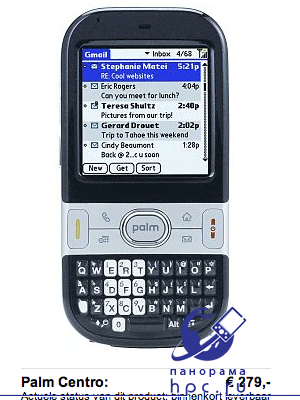 |
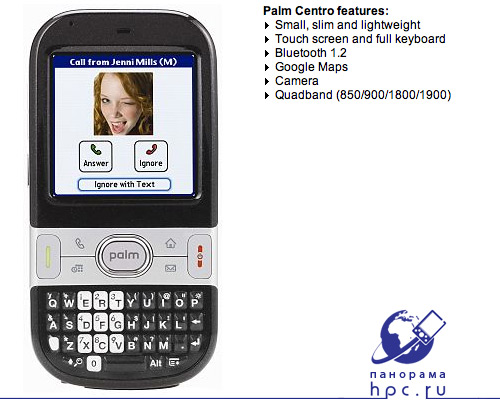 |
GSmart-intrigue
Manufacturers of Windows Mobile devices continue to prepare for the Mobile World Congerss, which runs from February 11 to 14 in Barcelona. At this time the company has intrigued fans Gigabyte Communications. On the teaser image, sent out a press, you can observe three communicator, one for each direction of the portfolio GSmart. One of them, with an emphasis on the ability of television viewing is likely to be "well-forgotten old" model, GSmart t600. Recall that this model Gigabyte introduced at last year's 3GSM World Congress, it was one of the first PDA with a display with a resolution of VGA. We also can not exclude the possibility that, at Mobile World Congerss we will show an updated model that retained the design GSmart t600 and get new features.
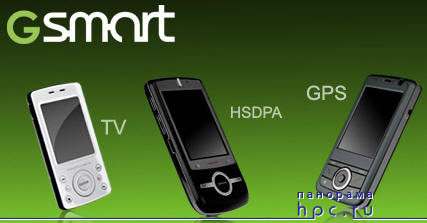 |
Two other communicator GSmart expanding range of Gigabyte in the segments of GPS and HSDPA. Do not be surprised that HSDPA is allocated in a separate direction. For a long time, Gigabyte released a device only for GSM networks, and last year unveiled the first model to support high-speed mobile standard HSDPA. The debutant was sharpened by mobile communications, including text messages, this device was equipped with a QWERTY-keyboard. However, a full-fledged debut did not work, GSmart q60 has not reached the shelves. In contrast, GSmart q60, model shown in the picture, designed as a classic candy bar, no QWERTY-excesses are observed. GPS-novelty in the style similar to the GSmart i350, which will be functional differences as long as it is not clear. In describing the model separately mentioned function GeoTag, which continues the tradition of Gigabyte equip communicators software with great features, benefits apart from the competition.
Samsung against the iPhone in September
Mysterious smartphone Samsung i900 really worked in the bowels of the Korean telefonostroitelya. The representative of the French subsidiary Samsung said in confidence to journalists that the new flagship line of Windows Mobile will be presented at the Mobile World Congress in Barcelona, but the commercial edition will be held in September. It realize the dream of everyone who is not satisfied with the length and beauty of the specification mobile phone from Apple. The ability to install third party applications (fair chance, without hacking), 5-megapixel camera, GPS-module, FM-radio, extra memory cards via microSD, support UMTS / HSDPA and the like. Nevertheless, all statements that are "killer iPhone" pretty weird. And here's why. One nuance Samsung i900 lose now - display resolution. With a similar display size (diagonal of 3,5 inches) from the Samsung is not 320x480, and 240x400 pixels. Support for third-party applications for iPhone will appear in the very near future - in February will be released on the official SDK for software developers. In addition, until September, Apple enough time to carefully plan and carry out "anti-terrorist campaign."As practice shows, any attempts to "kill the iPod" ended in failure, and Apple maintains a strong leadership position in digital music players. In the field of mobile phones until Apple newbie, but is rapidly gaining points in its favor. If we discard the wrong comparison to the iPhone, the Samsung i900 is a pretty interesting device, which will definitely find its customers. He demonstrates an integrated approach to the concept of a mobile device, though not "re-invents the telephone, as did Apple last year. The illustration shows a possible design of the model, how it will look like in reality, we will know closer to the February show.
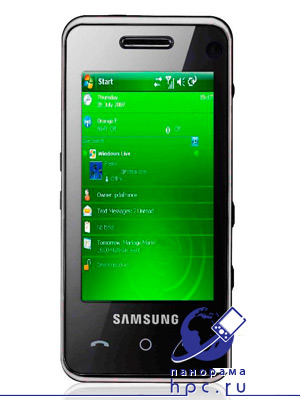 |
Touching GPS, all in white
In the line of HTC Touch is now represented by three devices - a miniature candy bar for HTC Touch GSM-networks, the slider HTC Touch Dual for third generation networks and GPS-model of the HTC Touch Cruise. According to recent data, since the release of the first communicator Touch series in mid-summer last year, the Taiwanese company has sold more than two million units, a similar success with the HTC was not. There is no doubt that a successful series will be expanded further. One of these "extensions" will soon be the American operator Verizon Wireless. Externally from repeating the first model in the series, but there are many internal differences. In the CDMA-version of the HTC Touch supports standard, high-speed EV-DO, but this is not the main difference from the classic version of HTC Touch. In the model XV6900 Touch has an integrated GPS-receiver, making him the envy of many fans of the HTC Touch, using communication services in standard GSM. All the same, only until the GPS-model in the series, HTC Touch Cruise, is significantly different in design from sverhuspeshnogo HTC Touch, which alone has sold millions of copies all over the summer and autumn of last year. Interestingly, the CDMA-version of the HTC Touch for other U.S. carriers such as Sprint, do not include GPS-functionality. It is not excluded that after a while history may repeat itself, and in the GSM-world appears older brother HTC Touch with GPS-talents. Otherwise, XV6900 Touch is no different from counterparts: a 2-megapixel camera, TouchFLO Finger friendly, and the operating system Windows Mobile 6 Professional.
 |
Virtual keyboard without a touchscreen
Original solution to the problem of virtual keyboards invented company Nokia. Developers of many mobile devices are fighting to create a truly user-friendly keyboard, not sold in hardware and software. Suggested solutions until a virtual keyboard on touch screens are far from ideal and does not provide a text input method, any comparable in convenience to the hardware QWERTY. Nokia decides to go even further and come up with a virtual keyboard for devices without a touchscreen, the benefit of Symbian-smartphones with touch capabilities will appear in the Finnish manufacturer is not soon. The development, described in another patent application proposes to use for entering text literally any surface. The smartphone is located so that the camera was zoomed to the selected surface, and the device's screen is painted keyboard. The result is drumming his fingers on the table, the camera tracks the movement of the keyboard on the screen draws the touch of a finger "button and the microphone reproduces the sounds of taps. Thus, the user gets the opportunity to fairly easy text input without increasing the dimensions of your smartphone from a hardware QWERTY-keyboard, and without the need for a separate keyboard hook. It is worth noting that this development has not solved the main problem of virtual keyboards - the impossibility of typing in the blind.Will it be just a little more comfortable than the standard input using the number keys are also not yet clear.
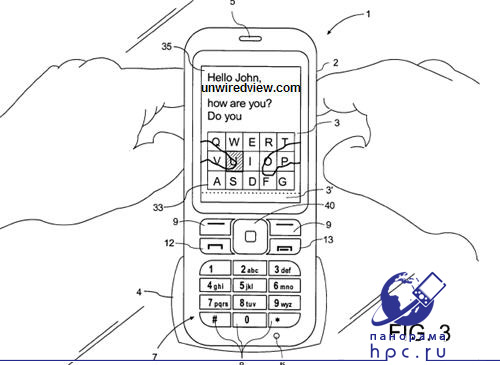 |
Ultra future Inventec
A new class of devices, which through a couple of years, will replace PDAs and communicators, continues its development. UMPC 7-A and 5-D, developed by Inventec, have won prestigious awards IF Product Design Award 2008 for design. Inventec UMPC 7-A is a slider with QWERTY-keyboard. A highlight here is a rounded slider mechanism, through which the display is raised at an angle above the surface when the keyboard is advanced, making it easier to work at the table. In Inventec UMPC 5-D using the modular principle, moreover, included will be interesting to go docking station. This approach allows us to provide easily scalable functionality in a single model.
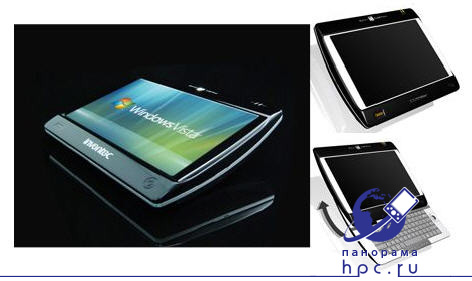 |
| Inventec UMPC 7-A |
As can be seen in the illustrations, both devices are running the operating system Windows Vista. From the tactical and technical characteristics known so far not much. Intel Menlow platform with the processor Silverthone, manufactured on 45 nm process, with a clock frequency of 800 - 1,33 GHz, chipset, Poulsbo US15, 1 to 2 GB of RAM, hard drive capacity of 30-60 GB. Models with these parameters appear in this year's abundant, it is quite possible that new items Inventec will be issued under the various well-known brands.
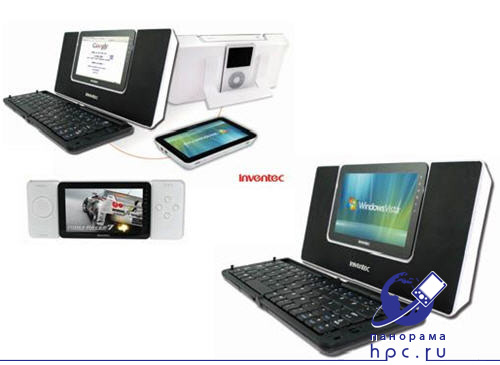 |
| Inventec UMPC 5-D |
Folding smartphone for originals
Device using electronic paper are gradually shifting from the category of fiction simply exotic. Has already produced several models of electronic books using displays based on e-paper, and by mid-year will be the first phone with a folding screen. Last year, Polymer Vision showed a prototype device Readius, and now has announced the imminent passage of the project into a commercial stage. In the collapsed state of the gadget is quite traditional for the phone size and weight - 115x57x21 mm, 115 grams. However, the display had, by the standards of the phone is huge - a diagonal of 5 inches. If necessary, the display is expanded to its full width, and when it is not needed, compactly formed. While the device is severely limited in the work with the content - affects specificity of electronic paper. The screen can display only 16 shades of gray, no support for working with video. Recall that the main advantage of "electronic paper" that energy is expended only for rendering the image, rather than maintain it. That is, if the display will show one picture, and tighter, the energy use will be minimized. When working with video, this immediately turns into a plus minus - must draw a picture too often. Nevertheless, some companies continue to develop in the field of electronic paper and in five years Polymer Vision plans to release a phone with an 8-inch color screen and video support.
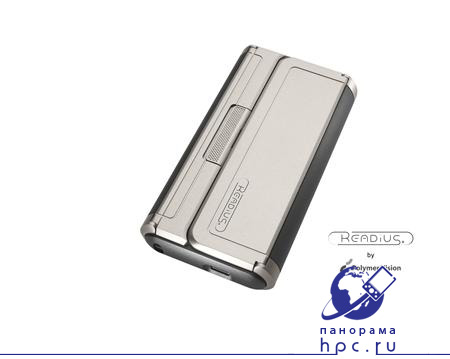 |
It is assumed that the user Readius will see news, check email and read books in electronic form.As a phone Readius will support GSM and UMTS / HSDPA, USB 2.0 and Bluetooth 2.0, in addition provides the functionality of MP3-player and card slot microSDHC. On which platform the company operates the device does not say directly, but in the specifications referred to ARM11 processor with 400 MHz and support for ActiveSync. It is not clear until the end, whether the user has the freedom to choose and install applications, or you have limited set offered by the manufacturer. There is a possibility that the entire interface customization, and optimization of content and services will be conducted through a special Web-portal of the Readius. It is unlikely that such a gadget will become massive in the near future. This will be a toy for a few originals, wishing to join the world of high technology. And that means there is little point in making the platform open for third-party software developers, at least not yet.
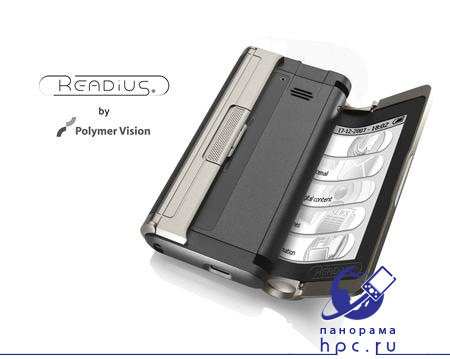 |
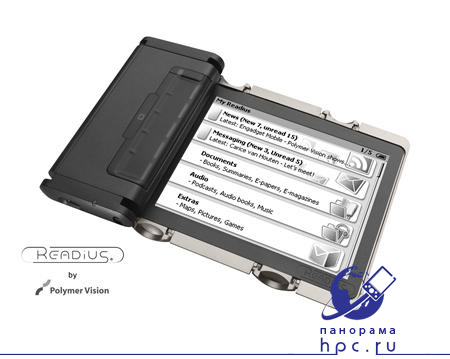 |
The authors, translation:
K. Nemo












